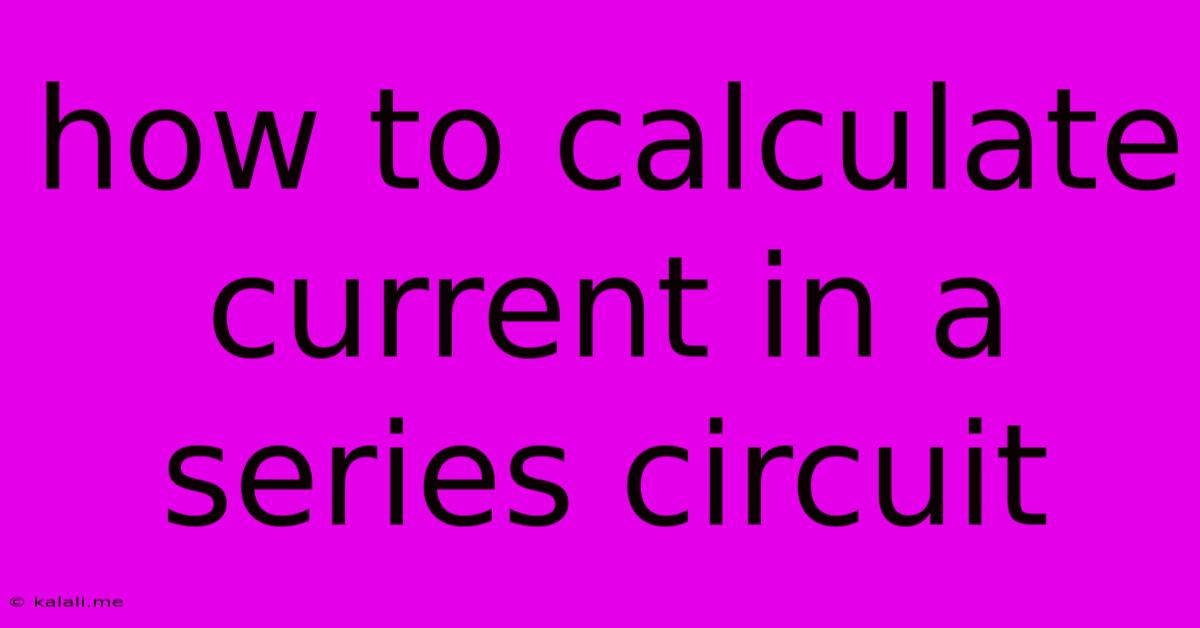How To Calculate Current In A Series Circuit
Kalali
Jun 08, 2025 · 3 min read

Table of Contents
How to Calculate Current in a Series Circuit: A Simple Guide
Calculating the current in a series circuit is a fundamental concept in electricity. Understanding this allows you to analyze and design various electrical systems. This guide will walk you through the process, explaining the principles and providing a step-by-step approach. We'll cover Ohm's Law and its application to series circuits, helping you master this essential electrical calculation.
Understanding Series Circuits and Ohm's Law
A series circuit is a closed-loop path where components are connected end-to-end, forming a single pathway for current flow. This means the current flowing through each component is the same. This is in contrast to parallel circuits, where the current divides among the branches. The key to calculating current in a series circuit is Ohm's Law:
V = IR
Where:
- V represents voltage (measured in volts, V) – the electrical potential difference driving the current.
- I represents current (measured in amperes, A) – the flow of electric charge.
- R represents resistance (measured in ohms, Ω) – the opposition to the flow of current.
In a series circuit, the total resistance (R<sub>total</sub>) is simply the sum of the individual resistances (R<sub>1</sub>, R<sub>2</sub>, R<sub>3</sub>, and so on). Therefore:
R<sub>total</sub> = R<sub>1</sub> + R<sub>2</sub> + R<sub>3</sub> + ...
Calculating Current: A Step-by-Step Approach
Let's break down how to calculate the current (I) in a series circuit:
-
Identify the voltage (V): Determine the total voltage supplied to the series circuit. This is usually provided in the problem statement or can be measured using a voltmeter.
-
Calculate the total resistance (R<sub>total</sub>): Add up the resistance of all components in the series circuit. Make sure all resistances are in the same units (ohms).
-
Apply Ohm's Law: Use the formula I = V / R<sub>total</sub> to calculate the current. Substitute the values you found in steps 1 and 2.
-
Units: Remember that the current (I) will be expressed in amperes (A).
Example Calculation
Let's say we have a series circuit with a 12V battery and three resistors: R<sub>1</sub> = 2Ω, R<sub>2</sub> = 4Ω, and R<sub>3</sub> = 6Ω. Let's calculate the current:
-
Voltage (V): V = 12V
-
Total Resistance (R<sub>total</sub>): R<sub>total</sub> = R<sub>1</sub> + R<sub>2</sub> + R<sub>3</sub> = 2Ω + 4Ω + 6Ω = 12Ω
-
Current (I): I = V / R<sub>total</sub> = 12V / 12Ω = 1A
Therefore, the current flowing through this series circuit is 1 ampere.
Troubleshooting and Common Mistakes
-
Unit Consistency: Ensure all your values are in consistent units (volts, ohms, amperes) before applying Ohm's Law. Converting units incorrectly is a common source of error.
-
Adding Resistances in Parallel: Remember that this method applies only to series circuits. Calculating the total resistance in a parallel circuit requires a different formula (1/R<sub>total</sub> = 1/R<sub>1</sub> + 1/R<sub>2</sub> + 1/R<sub>3</sub> + ...).
-
Misreading Circuit Diagrams: Carefully examine the circuit diagram to ensure you've correctly identified which components are in series and their respective resistance values.
By following these steps and understanding the principles behind them, you can confidently calculate the current in any series circuit. Remember that practice is key to mastering these concepts. Working through several examples will solidify your understanding and help you avoid common pitfalls.
Latest Posts
Latest Posts
-
Power Bank To Charge Dead Vehicl Ebattery
Jun 08, 2025
-
I Love The Name Bastard Sword
Jun 08, 2025
-
How To Remove Scuff Marks On A Car
Jun 08, 2025
-
How Long Can Chicken Be Left Out
Jun 08, 2025
-
Why Did Aquaman Kill Black Mantas Father
Jun 08, 2025
Related Post
Thank you for visiting our website which covers about How To Calculate Current In A Series Circuit . We hope the information provided has been useful to you. Feel free to contact us if you have any questions or need further assistance. See you next time and don't miss to bookmark.